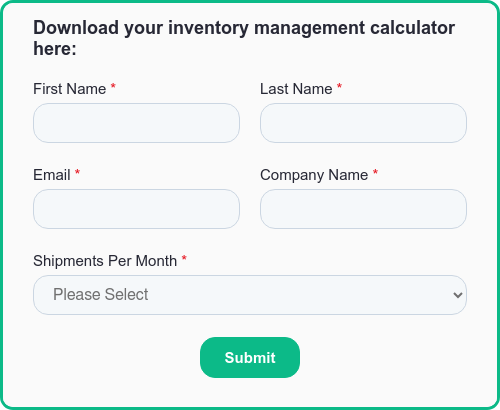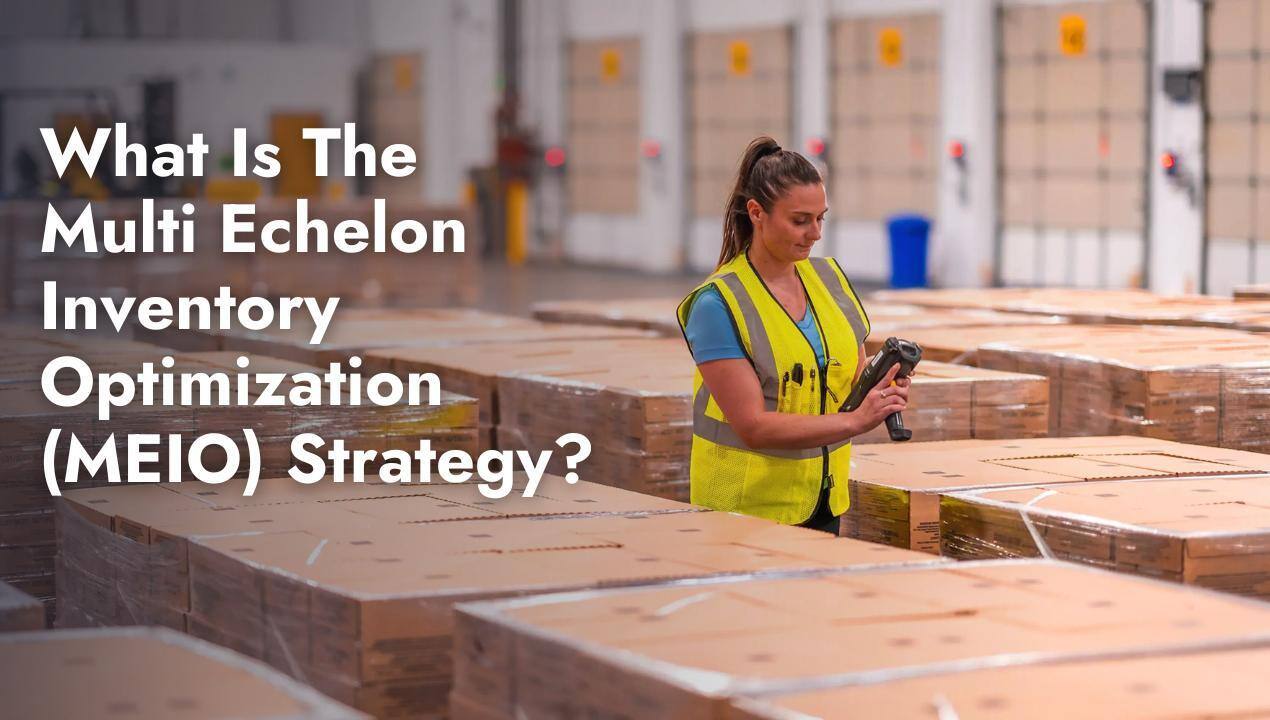Share this
What Is A Perpetual Inventory System For Ecommerce?
by Kyla Friel on Oct. 27, 2023

Inventory is one of the most important elements of your business. But it can also be one of the most difficult to stay on top of. The most traditional way to maintain your inventory is through a periodic inventory system that requires consistent physical counts. A perpetual inventory system, on the other hand, is a way of monitoring your inventory in real time.
Perpetual inventory systems for ecommerce can redefine your stock management systems, transforming your business for the better. In this article, we’ll take a closer look at perpetual inventory systems for ecommerce and the value they can bring to your company.
What Is a Perpetual Inventory System?
A perpetual inventory system is a method of tracking a company’s stock levels in real time. This happens automatically using technology, making it easy to maintain accurate stock counts.
The latest perpetual inventory systems use cloud software to provide the most up-to-date data. This allows ecommerce business owners and professionals to monitor and control their stock levels wherever they are.
Key Features
Perpetual inventory systems contain several useful features that make inventory management easier and more effective. Some of these features include:
Real-time Inventory Updates:
- Automatically updates stock levels based on online sales, ensuring accurate inventory counts at all times.
Integration with Ecommerce Platforms:
- Seamlessly syncs with online sales platforms to track inventory changes resulting from online transactions.
Automated Purchase Orders:
- Suggests or generates POs based on stock levels and sales trends, aiding in timely restocking.
Detailed Reporting & Analytics:
- Provides insights into online sales trends, best-selling products, and inventory turnover, helping in informed decision-making.
Reorder Point Notifications:
- Sends alerts or notifications when stock reaches predetermined thresholds to minimize stockouts and optimize inventory levels.
Barcode or RFID Integration:
- Streamlines the receiving process and ensures quick product identification during order fulfillment.
COGS Tracking:
- Calculates and monitors the Cost of Goods Sold, providing insights into product profitability and helping in pricing strategies.
Returns Management:
- Efficiently manages ecommerce product returns from online customers, adjusting stock levels and financial records accordingly.
Multi-Location Support:
- If the ecommerce business uses multiple warehouses or fulfillment centers, the system can track inventory separately for each location.
The various features of perpetual inventory systems provide vital functions for businesses beyond simply monitoring stock levels. Perpetual inventory can save time and money by allowing for greater accuracy and enhanced productivity for more efficient business operations.
The Difference Between Perpetual Inventory and Periodic Inventory Systems
There are two main types of inventory management: perpetual inventory and periodic (physical) inventory. Of the two systems, perpetual inventory is the most accurate, and perhaps simplest way to manage your inventory.
The perpetual inventory system and the periodic inventory system differ primarily in how they track and update inventory records. In a perpetual inventory system, inventory records are updated in real time when transactions occur. This approach uses technology and software to ensure that inventory levels are always current.
The periodic inventory system involves updating inventory records based on periodic physical counts. These counts will typically occur at specific intervals, like the end of a fiscal year. Businesses using this system will manually count or verify their inventory and adjust their records based on this count.
Many businesses use cycle counts, where parts of inventory are counted at more frequent intervals without counting the entire inventory. In between these counts, purchases are recorded in a separate purchases account. The actual inventory record remains unchanged until the next scheduled physical verification.
Physical inventory counts can be useful for businesses that operate mainly offline. They can also work for smaller businesses that don’t have higher inventory volumes to deal with. Larger ecommerce businesses will find that perpetual inventory systems save time and leave little room for mistakes, making inventory management much simpler.
What are the Pros and Cons of a Perpetual Inventory System?
More and more ecommerce businesses are turning to perpetual inventory systems to enhance their operations. Here are the pros and cons to help you decide if this system is right for your business:
Pros
Maintains real-time data
As detailed above, perpetual inventory systems provide real-time data tracking of inventory levels. This helps automate the process of inventory management, allowing businesses to track their stock levels at any given time.
Increases accuracy
Unlike physical inventory systems, perpetual inventory systems are highly accurate, reducing the number of errors in inventory management. Accuracy helps save on costs by ensuring all stock is accounted for.
Offers inventory insights
The system can help identify your low-selling products so you can rethink strategies to sell them quickly. This will allow businesses to optimize their stock and make more informed decisions relating to demand.
Improves customer satisfaction
Thanks to more accurate inventory data, your customers can avoid the disappointment caused by out-of-stock items. This can lead to more positive user experiences, and generate better reviews for your business.
Enhances efficiency and productivity
Using an automated process can save businesses a lot of time by boosting productivity. It can reduce the possibility of errors that cause delays and take extra resources to fix.
Saves on costs
With an up-to-date inventory, you can avoid some of the issues caused by overstocking (excess inventory) or stockouts. This can free money tied up in stock, and help utilize warehouse space more efficiently.
Cons
Initial investment
Establishing a perpetual inventory system requires some initial investment, which may not always be within reach for small businesses. Alongside the software, there will be further costs incurred from hardware and training.
Complexity
Perpetual inventory systems require a degree of expertise to ensure they can be implemented and maintained effectively. Using a Third-Party Logistics (3PL) partner can help resolve some of these issues to ensure the system runs smoothly.
Ongoing maintenance
Manual audits will need to be carried out to validate the accuracy of the perpetual inventory data. This can be a time-consuming process, especially if there is a particularly high inventory turnaround within the company.
Lack of benefits for small businesses
Most perpetual inventory systems are designed for larger ecommerce businesses. Smaller businesses may be put off by the cost, and those with less inventory may not get the full value of this type of system.
Formulas for Perpetual Inventory Systems
Using formulas can increase inventory accuracy and inform decision-making. Strategic decisions concerning orders, warehouse space, cost, and more can be made based on the insights these formulas provide. Some of the key formulas used by perpetual inventory systems include:
Cost of goods sold (COGS)
COGS provides useful information about the cost of goods sold during a specified period, helping to determine how profitable operations are. The COGS formula is:
COGS = Opening Inventory + Purchases – Closing Inventory
Gross profit
This is the difference between total revenue and the cost of the goods sold. The gross profit formula is:
Gross Profit = Revenue – COGS
Weighted average cost
This method determines the cost of items sold by averaging the total cost of all items available for sale. It’s ideal for businesses with similar or identical inventory items and those not tracking individual item costs. The weighted average cost formula is:
Weighted Average Cost = (Total Cost of Goods Available for Sale) / (Total Quantity Available for Sale)
Reorder point
The reorder point is the level at which a new order should be placed to replenish stock, helping to avoid stockouts. The system is programmed with typical lead times and a safety stock buffer. The reorder point formula is:
Reorder Point = (Lead Time Demand) + (Safety Stock)
Economic Order Quantity (EOQ)
EOQ can determine the optimal order quantity to reduce inventory costs. It takes into account demand (D), setup/ordering costs (S), and holding/carrier costs (H). The economic order quantity formula is:
EOQ = sqrt((2 * D * S) / H)
FIFO
FIFO is the ‘first in, first out’ method of inventory valuation. With this method, the oldest stock (i.e., the stock that has been in inventory the longest) is considered to be sold first. This can be particularly useful for goods that have a use-by or expiration date.
LIFO
LIFO is the ‘last in, first out’ method of inventory valuation. With this method, the most recently acquired or produced items are considered to be sold first. It’s used in some accounting practices to calculate COGS, particularly when prices are rising, as it can result in higher cost expenses and lower reported profits. Both the LIFO and FIFO methods can be used to calculate the ending inventory formula for your business.
You can download our free inventory management calculator template which includes the formulas for ending inventory, the reorder point, and the inventory turnover ratio, giving you immediate insight into your company’s inventory situation.

How Does a Perpetual Inventory System Work?
A perpetual inventory system provides a simple way of tracking inventory information by updating sales channel data in real-time. As stock levels are updated, businesses can be confident that they are getting the most accurate information about their inventory. Here are the steps involved to make a perpetual inventory system work:
1. Point-of-sale (POS) provides instant updates
A successfully integrated POS system allows inventory levels to be updated automatically once a sale takes place. Products feature either a barcode or an RFID, which are scanned to assist with tracking.
Items sold are then deducted from the available inventory, while accounts are also updated to provide the latest revenue balances.
2. Cost of goods sold (COGS) is updated
In a perpetual inventory system, the software maintains a running list of transactions, ensuring that the COGS is always updated after each sale. This continuous update provides you with current financial data for your business. This real-time information is reflected in your inventory, assisting you in making informed decisions about reordering products.
3. Reorder points are updated
Using historical data, the perpetual inventory system will monitor your stock levels, determining the best time to order new stock. It may increase the amount of inventory needed by taking into account the popularity of products ordered at certain points.
4. Purchase orders (PO) are created
As items approach their reorder points, POs are automatically generated to place orders with your suppliers. This helps you maintain steady stock levels and reduces the risk of stockouts.
5. Received stock is scanned and included in the inventory
Scanning new stock that is delivered to your warehouse or storage location will automatically update your inventory levels. These levels should be connected to your ecommerce store, updating available stock counts instantly and ensuring items are able to be purchased.
Which Businesses Can Benefit From Perpetual Inventory Systems?
Poor inventory management can cost businesses money. In 2022, more than $349 billion was lost as a result of stockouts. As more and more people shop online, it becomes critical that businesses manage inventory levels effectively, helping to establish demand and take advantage of selling opportunities. Some of the businesses that can benefit the most from a perpetual inventory system include:
- Large scale ecommerce businesses, and those with multiple locations or shipping destinations.
- Businesses with several inventory items to keep track of.
- Businesses looking to scale up.
Some businesses that may struggle to use a perpetual inventory system include those with limited stock who can monitor purchasing trends more easily. Smaller retailers may also find a periodic inventory system more practical and more affordable.
Is a Perpetual Inventory System Right for You?
Perpetual inventory systems offer many benefits to ecommerce businesses, helping to keep track of inventory, while also informing strategic decisions and providing valuable performance data. Once in place, a perpetual inventory system will provide accurate information, and become easy to manage, provided processes are followed correctly. But that’s only one part of the fulfillment process – and it can prove difficult to keep up with everything while also trying to grow your business.
You can outsource your order fulfillment to a top-rated Third-Party Logistics (3PL) provider like Shipfusion to optimize your inventory management, warehousing, and the packing and distribution of all of your ecommerce orders. At Shipfusion, we make it easy for you to manage your business effectively while being able to monitor and analyze your performance.
Contact one of our fulfillment experts to learn more about Shipfusion’s proprietary inventory management software and turnkey fulfillment solutions today.
Share this
You May Also Like
These Related Articles

Using the Weighted Average Method for Inventory

How to Calculate the Inventory Turnover Ratio for Ecommerce

What Is the Multi Echelon Inventory Optimization (MEIO) Strategy?
- April 2025 (18)
- March 2025 (26)
- February 2025 (26)
- January 2025 (37)
- December 2024 (16)
- November 2024 (23)
- October 2024 (22)
- September 2024 (27)
- August 2024 (9)
- July 2024 (8)
- June 2024 (5)
- May 2024 (8)
- April 2024 (8)
- March 2024 (6)
- February 2024 (6)
- January 2024 (5)
- December 2023 (3)
- November 2023 (3)
- October 2023 (5)
- September 2023 (4)
- August 2023 (2)
- July 2023 (1)
- June 2023 (4)
- March 2023 (2)
- October 2022 (1)
- September 2022 (5)
- August 2022 (4)
- July 2022 (7)
- June 2022 (4)
- May 2022 (4)
- April 2022 (6)
- March 2022 (2)
- February 2022 (1)
- January 2022 (3)
- December 2021 (2)
- November 2021 (4)
- October 2021 (2)
- September 2021 (5)
- August 2021 (4)
- July 2021 (4)
- June 2021 (3)
- May 2021 (2)
- April 2021 (3)
- March 2021 (3)
- February 2021 (3)
- January 2021 (2)
- December 2020 (4)
- November 2020 (2)
- October 2020 (4)
- September 2020 (2)
- July 2020 (5)
- June 2020 (4)
- May 2020 (2)
- April 2020 (2)
- March 2020 (4)
- February 2020 (1)
- December 2019 (1)
- May 2018 (1)
- March 2018 (2)
- February 2018 (3)
- January 2018 (3)
- November 2017 (3)
- July 2017 (4)
- March 2017 (3)
- February 2017 (5)
- January 2017 (3)
- December 2016 (4)
- November 2016 (6)
- October 2016 (6)
- October 2015 (1)
- September 2015 (1)
- June 2015 (3)
- May 2015 (3)
- August 2014 (1)
- July 2014 (1)
- March 2014 (1)
- February 2014 (1)